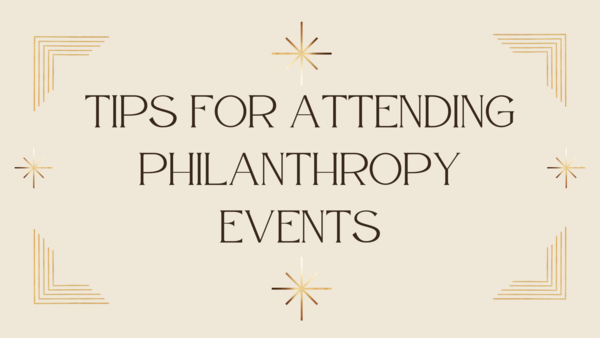Tips for Attending a Philanthropy Event

Tips for Attending a Philanthropy Event
When researching the organization hosting an event, it is important to gather information about its mission, previous events, and target audience. This will help you understand the organization's goals, values, and the audience they are trying to reach. By understanding these aspects, you can effectively promote the event and align your strategies with the organization's objectives. To research the organization hosting the event, begin by visiting their website and reading their mission statement. This will provide insights into their overall purpose and values. Additionally, exploring their previous events can give you an understanding of the types of activities they engage in and the impact they have had in the past.
It is also crucial to identify the organization's target audience. Look for information regarding who they are trying to reach and engage with through their events. This will help you tailor your promotional efforts to the right audience and ensure that your messaging resonates with their interests and needs. Other key factors to consider when researching the organization include its history, reputation, and community involvement. Understanding their history can give you a sense of their longevity and experience in hosting events. Assessing their reputation will provide insights into how they are viewed within their industry or community. Finally, identifying their level of community involvement can indicate their level of outreach and impact.
To understand the cause and mission of an organization, thorough research is essential. One must start by identifying the purpose and objectives that drive the organization. This can be found in the organization's vision or mission statement, which should clearly outline what the organization seeks to achieve and how it plans to do so. When researching, it is important to pay attention to whether the organization has a focus on fundraising. This information can typically be found on the organization's website or in its annual reports. Understanding the organization's fundraising activities will give insights into how it sustains its operations and delivers on its mission.
Additionally, it is crucial to look for evidence of the organization's impact. This can be seen through success stories, testimonials, or data and statistics highlighting the difference they have made in the cause they support. Demonstrating impact is crucial for building trust and credibility, as it shows that the organization is effectively working towards achieving its mission. To ensure that the mission remains central to promotional strategies, it is vital to look for campaigns and initiatives that align with the organization's mission. Researching past promotional materials, events, or partnerships can provide insights into how the organization communicates its purpose and engages with its supporters. Overall, by thoroughly researching the cause, mission, purpose, objectives, and fundraising efforts of an organization, one can gain a comprehensive understanding of its values, impact, and promotional strategies.
Register for the event in advance
To register for the event in advance, follow the steps provided in the Background Information. First, visit the event website or designated registration platform. Look for the "Register" or "Buy Tickets" button, and click on it. This will take you to the event registration page. On the registration page, you will usually need to provide some basic information about yourself, such as your name, contact details, and any additional information requested. Make sure to fill out all the required fields accurately.
Next, you will see the ticket price tiers. Select the ticket type that corresponds to your preferences or needs. If there are multiple options available, choose the one that suits you best. The ticket price tiers may include different benefits or access levels, so take your time to review and decide accordingly. After selecting your ticket type, you may have the option to customize your registration form. This allows you to provide additional information or answer specific questions if required. Fill out the form accordingly, taking note of any mandatory fields. Once you have completed the registration form, proceed to the payment section. Follow the prompts to securely make your payment using the provided payment methods. After completing the payment process, you should receive a confirmation email with your event registration details.

Setting Fundraising Goals
Setting fundraising goals is an essential step for any organization or individual looking to raise money for a cause. Clear and specific goals provide a roadmap for the fundraising campaign, helping to focus efforts and track progress. Without well-defined goals, fundraising can become aimless and less effective. Whether it is to raise funds for a specific project, cover operational costs, or support a charitable mission, setting fundraising goals offers numerous benefits. This article will explore the importance of setting fundraising goals and provide practical tips on how to do it effectively. By establishing realistic and attainable targets, organizations and individuals can maximize their fundraising efforts and achieve the desired outcomes.
Determine how much you are willing to donate or fundraise
Determining a specific amount to donate or fundraise for your fundraising event is of utmost importance. This decision allows you to set a clear goal and provides a tangible target that can motivate participants. Having a specific amount in mind gives your event a sense of purpose and direction. It allows you to communicate a clear message to your participants, explaining exactly what you are working towards and why their involvement is crucial. This clarity helps in motivating and engaging individuals to contribute their time, resources, and efforts toward achieving the set goal.
When deciding on the amount, several factors must be considered. Firstly, it is important to assess the financial needs of the organization you are fundraising for. Understanding the specific requirements and goals of the organization will help determine an appropriate amount that can make a significant impact. Secondly, event expenses need to be taken into account. Consider the costs associated with organizing the fundraising event, including venue rental, marketing materials, catering, and any other necessary logistics. Deducting these expenses from the total amount raised will give an accurate measure of the actual donation or funds raised for the cause. Lastly, consider the potential donor's capacity and their ability to contribute. Evaluate the reach of your event and the target audience you are trying to engage. This will help gauge the realistic expectations for donations and set a target that is attainable.
Set a goal for engaging with potential donors or sponsors
Setting a clear goal is the first step in engaging with potential donors or sponsors for your nonprofit event. Without a clear objective, your efforts may be scattered and less effective. Your goal should be specific, measurable, achievable, relevant, and time-bound (SMART). This could be raising a certain amount of funds, securing a specific number of sponsors, or increasing brand awareness.
Identifying potential partners who share a similar mission or target audience is crucial. By aligning with organizations or businesses that have a similar purpose or target audience, you can leverage their existing network and enhance the chances of securing sponsorships. When approaching potential sponsors, it is important to create a compelling proposition. This means clearly outlining what your organization can offer in return for their support. Emphasize the mutual benefits that can be gained from a partnership, highlighting how their involvement will help them reach their own goals.
Sponsorships have the potential to greatly enhance brand reputation, reach, and customer engagement. By associating with a nonprofit event, sponsors can demonstrate their commitment to social responsibility and improve public perception of their brand. Sponsors can also benefit from increased reach and exposure to a new audience. Through event promotions, their brand can be showcased to attendees, as well as through online and media coverage. Additionally, engaging with sponsors can lead to increased customer engagement opportunities such as collaborations, co-branded initiatives, or exclusive deals for their customers.

Networking Strategies
Networking Strategies play a crucial role in today's professional world, helping individuals connect, collaborate, and expand their career opportunities. These strategies involve deliberate efforts and techniques aimed at building and nurturing professional relationships, both online and offline. From attending industry events and leveraging social media platforms to cultivating meaningful connections and seeking out mentorship, effective networking strategies can open doors to new opportunities, enhance skill development, and foster long-term career growth. In this article, we will explore various networking strategies that professionals can employ to establish a strong network, enhance their professional visibility, and reap the benefits of a well-connected professional circle.
Introduce yourself to key stakeholders and major donors
When it comes to building a successful organization, establishing strong relationships with key stakeholders and major donors is of utmost importance. These individuals play a crucial role in the growth and success of the organization. One of the most effective ways to introduce yourself to these key stakeholders and major donors is through personalized communication. Connecting with the key stakeholders and major donors allows you to build a relationship based on trust and mutual understanding. By reaching out and introducing yourself personally, you are showing them that you value their support and are dedicated to cultivating a strong partnership. This step is vital as it sets the foundation for a long-lasting relationship that can greatly impact the organization's fundraising efforts.
Establishing connections with these individuals has numerous benefits. Firstly, it increases the chances of securing significant financial contributions. Major donors have the potential to make substantial donations, whereas key stakeholders may provide ongoing support and resources that are vital to organizational growth. Additionally, these individuals can serve as advocates for the organization, raising awareness and encouraging others to get involved. Fundraising efforts are significantly enhanced when key stakeholders and major donors are engaged. They provide not just financial support, but also valuable expertise and networks which can open doors to new opportunities and partnerships. Being able to tap into their knowledge and connections can greatly increase an organization's reach and impact.
Exchange contact information with others at the event
Networking plays a crucial role in any professional setting, and fundraising events are no exception. Building connections with other attendees can open doors to valuable resources, collaborations, and future opportunities. To effectively exchange contact information at fundraising events, consider the following practical tips. First and foremost, always come prepared with business cards. These small pieces of cardstock may seem old-fashioned in the digital age, but they remain an essential networking tool. They provide a professional way to exchange contact details quickly and easily. Be sure to have enough cards on hand and keep them easily accessible.
Another practical tip is to utilize technology. Many attendees now prefer to share contact information digitally. Use smartphone apps like LinkedIn or business card scanning apps to quickly collect and store contact details. These apps allow for seamless integration with your existing contact list and facilitate follow-up communications. Engage in meaningful conversations with other attendees and express genuine interest in their work or cause. After the conversation, politely ask for their contact information and make a note on their business card or your smartphone to remember where and when you met. This personalized touch will help you stand out and increase the likelihood of meaningful connections in the future. Lastly, don't forget to follow up promptly after the event. Send customized emails or messages to express your pleasure in meeting them and mention some key points from your conversation. Building connections requires consistent effort, and following up is a crucial step in turning initial introductions into lasting relationships.

Silent Auction Participation
Silent auctions provide a unique and exciting opportunity for individuals to participate in a fundraising event while also having the chance to bid on a wide variety of items and experiences. These auctions, as the name suggests, are conducted without the traditional live auctioneer and instead rely on written bids placed by attendees. With their growing popularity, silent auctions have become a widely used fundraising method for nonprofits, schools, and other organizations. This article will explore the various aspects of silent auction participation, including tips for increasing your chances of winning, understanding the bidding process, and how to make the most out of your experience. Whether you're a seasoned silent auction participant or new to the world of bidding, this guide will provide valuable insights and strategies to enhance your auction experience.
Review auction items before bidding
Reviewing auction items before bidding is crucial for making informed decisions and ensuring compatibility with desired experiences. This process allows bidders to thoroughly examine the items up for auction and determine if they meet their expectations and requirements. The importance of reviewing auction items cannot be overstated. It allows bidders to gain a comprehensive understanding of the item's features, condition, and any potential limitations. By carefully reviewing the details provided by the auctioneer, bidders can make educated assessments of the item's value and decide whether it aligns with what they are willing to spend.
Furthermore, reviewing auction items empowers bidders to ascertain the compatibility of the items with their desired experiences. For example, if someone is bidding on a vacation package, they can thoroughly review the accommodations, activities, and destinations included. This helps ensure that the auctioned item aligns with their preferences and desired vacation experience. Similarly, for collectors or enthusiasts, thoroughly reviewing the description, condition, and provenance of an auctioned item is vital to determine if it meets their specific requirements.
Set a budget for bidding on items
Setting a budget for bidding on items in an auction involves careful consideration of various factors, such as the value and popularity of items, estimating potential bidding prices, and determining a realistic budget. It is crucial to assess the value of the items up for auction. Conducting thorough research on similar items sold in the past can give an idea of their market value. By understanding the intrinsic worth of an item, bidders can avoid overpaying and set a more reasonable budget. Secondly, the popularity of an item affects its bidding price. Items in high demand tend to attract more bidders, which can drive up the final price. Being aware of an item's popularity can provide insight into the level of competition and assist in establishing a realistic budget.
Estimating potential bidding prices is a key step in setting a budget. This can be done by analyzing historical auction data, monitoring similar ongoing auctions, and consulting industry experts. By estimating the price range within which bidding is expected to occur, bidders can establish a suitable budget to prevent exceeding their financial limit. Lastly, determining a realistic budget is vital to avoid financial strain and ensure a satisfying bidding experience. Bidders should carefully evaluate their financial situation, set a maximum price they are comfortable paying, and adhere to it throughout the auction. A realistic budget should encompass not only the estimated bidding prices but also any additional expenses such as auction fees or transportation costs.
Strategize on which items to bid on based on their value
When strategizing on which items to bid on based on their value, several factors should be taken into consideration. The condition of the item is one of the first things to assess. Items in excellent condition are generally more valuable and have a higher resale potential. On the other hand, items in poor condition may not be worth bidding on, unless they have significant rarity or historical significance. Another important factor is rarity. Items that are difficult to find or have limited availability are often more valuable. This is especially true for collectors' items or items from a specific time period or with a unique feature. Such items tend to have a higher demand in the market.
Speaking of demand, it is crucial to assess the current demand for the item. Researching market trends and identifying what items are currently popular can help determine which items are worth bidding on. For example, if a particular item or brand is trending, its value is likely to increase. Furthermore, potential resale value should be considered. Some items may have a high initial value, but their resale potential may be limited. It is essential to evaluate the long-term value of the item and whether it can be sold at a profitable price in the future.

Maximize Your CSR and Social Impact Programs
DonationXchange robust philanthropy management software helps you streamline administrative tasks and maximize the impact of your donation dollars!
Watch the video:
How DonationXchange Can Help:
• Create & Track Fundraisers, Scholarships, Grants & More!
• Manage & Grow Donor Base
• Process, Track, and Analyze Donation Requests
• Manage Volunteer Opportunities
• Supercharge Employee Engagement
• Champion the Causes that Matter to YOU!
Schedule a demo today!